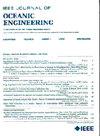Floating Offshore Wind Turbine Optimized Control for Power Regulation With Experimental Validation
IF 5.3
2区 工程技术
Q1 ENGINEERING, CIVIL
引用次数: 0
Abstract
This article proposes a new strategy for blade pitch control to regulate power production while alleviating the negative effects of the structural motions of floating offshore wind turbines (FOWTs). FOWTs frequently experience significant fluctuations in rotor speed when wind speed is above its rated value in the presence of significant wave heights. This condition reduces the power quality while amplifying the fatigue loads, which can result in damage to the generator. To address this problem, designers frequently use simplified models to design controllers, such as the gain-scheduled proportional integral (GSPI) controller. These models can demonstrate the nonlinear coupling of the platform motions and the rotor speed. However, their performance is limited due to the chosen linearization points. This article proposes an optimal design method based on metaheuristic algorithms. These algorithms treat the system as a black box, allowing for control parameter tuning considering all degrees of freedom, such as those provided by OpenFAST. The Red Tailed Hawk (RTH) Algorithm is used to create an optimized GSPI controller (RTH-GSPI) that maintains power while minimizing platform motion. Consequently, the performance is significantly enhanced. Numerical simulations using co-simulation between MATLAB and OpenFAST, along with experimental validation using an FOWT prototype, have verified the suggested technique's efficiency.浮式海上风电机组功率调节优化控制与实验验证
本文提出了一种新的叶片桨距控制策略,以调节发电,同时减轻浮式海上风力机结构运动的负面影响。当风速高于其额定值且存在显著波高时,fowt转子转速经常经历显著波动。这种情况降低了电能质量,同时放大了疲劳负荷,这可能导致发电机损坏。为了解决这个问题,设计人员经常使用简化模型来设计控制器,例如增益调度比例积分(GSPI)控制器。这些模型可以反映出平台运动与转子转速之间的非线性耦合。然而,由于选择的线性化点,它们的性能受到限制。提出了一种基于元启发式算法的优化设计方法。这些算法将系统视为一个黑盒,允许考虑所有自由度的控制参数调整,例如OpenFAST提供的那些自由度。红尾鹰(RTH)算法用于创建优化的GSPI控制器(RTH-GSPI),在保持功率的同时最小化平台运动。因此,性能得到了显著提高。利用MATLAB和OpenFAST联合仿真的数值模拟,以及使用FOWT原型的实验验证,验证了该技术的有效性。
本文章由计算机程序翻译,如有差异,请以英文原文为准。
求助全文
约1分钟内获得全文
求助全文
来源期刊

IEEE Journal of Oceanic Engineering
工程技术-工程:大洋
CiteScore
9.60
自引率
12.20%
发文量
86
审稿时长
12 months
期刊介绍:
The IEEE Journal of Oceanic Engineering (ISSN 0364-9059) is the online-only quarterly publication of the IEEE Oceanic Engineering Society (IEEE OES). The scope of the Journal is the field of interest of the IEEE OES, which encompasses all aspects of science, engineering, and technology that address research, development, and operations pertaining to all bodies of water. This includes the creation of new capabilities and technologies from concept design through prototypes, testing, and operational systems to sense, explore, understand, develop, use, and responsibly manage natural resources.
 求助内容:
求助内容: 应助结果提醒方式:
应助结果提醒方式:


